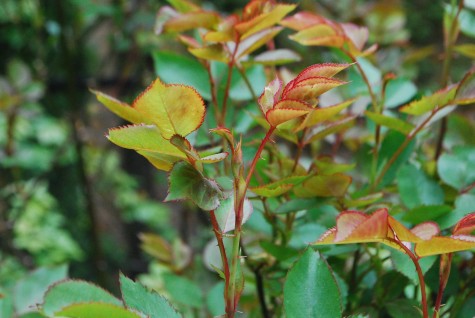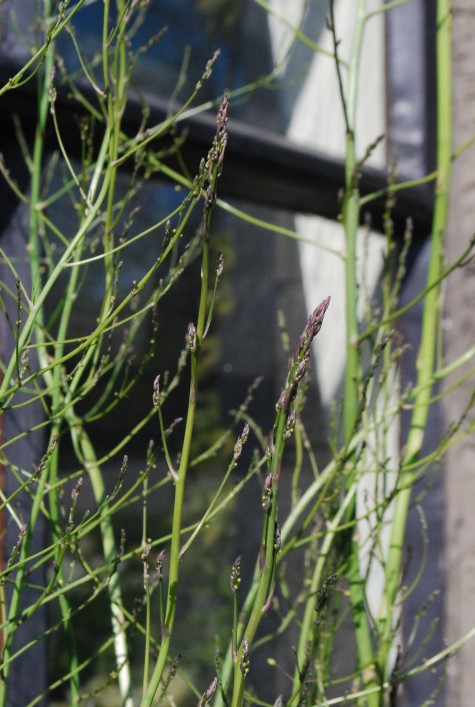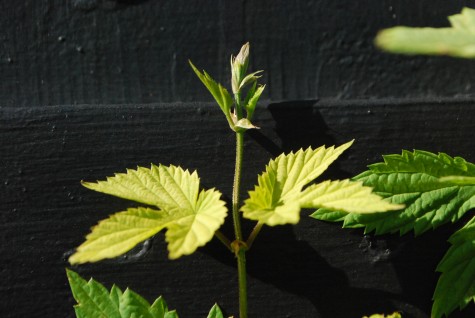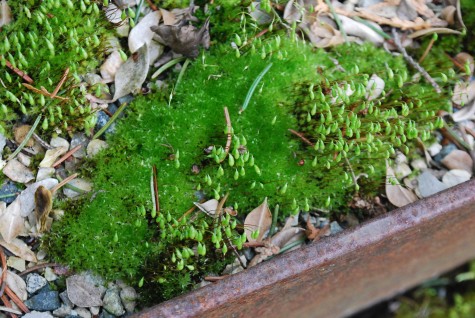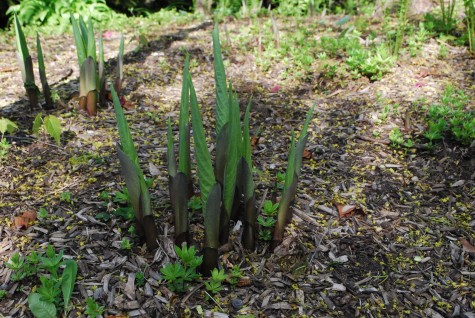
New shoots emerging is one of spring’s most exciting moments. A decision is made to break dormancy, and grow. A new shoot can be a leaf, or a stem or a flower. I imagine those elongated shapes makes quick work of pushing through the soil. These Sum and Sunstance hostas are grown under a number of trees and shrubs in a shady spot in my garden. Though I might have a tough time digging in this rooty soil, the hostas come out of the ground entirely unscathed. The leaves are rolled up tight. This spring stage, which is but a brief moment in the gardening season, is truly extraordinary.
It is an extraordinarily vulnerable moment as well. New shoots are soft and succulent-beloved of deer, rabbits and woodchucks. Lettuce leaves get tougher as they age. Baby vegetables-a delicacy. If you are a fan of eating dandelion greens chances are good you eat them at a very young age. Dandelion leaves in summer are tough and bitter tasting. The shoots of this clump of dwarf hosta are unfurling into leaves. As the leaves elongate and unfold, they will present themselves to the light by positioning themselves parallel to the ground. This up out and arching back takes place all within a matter of a few weeks.
The old saying that April showers bring May flowers has a solid basis in fact. The energy it takes to grow and push forth out of the ground is considerable. An ample suply of moisture is critical in the spring. Our spring has been alarmingly dry. I watered thoroughly in mid March and am still watering in April. The clematis on my bench broke dormancy in March-I was sure it would be frosted back to the stems when our temperatures were in the mid twenties. Not so. The vines were untouched, and are now in the process of setting flowering shoots. Both vines are loaded with buds.
Thelypteris decursive-pinnata is a mouthful of a botanical name for Japanese beech ferns. Most of the beech ferns are wild runners, and too unruly for home gardens, but this one is fairly well behaved, and lush growing. The leaf shoots emerge from the crowns rolled up like a hose. The unfurling of the long leaves is beautiful to watch. Early spring ostrich fern curls are popular in flower arrangements. This stage is just as beautiful as the full grown leaf. The European ginger leaves come up and open so fast it is an easy stage to miss altogether.
The new shoots on my roses are rosy indeed. The red edges of the leaves is a sure sign of a new leaf. So many spring leaves have a decidedly yellow cast. the centers of these new shoots are limey green. Chartreuse-another word for spring. The lower leaves of these roses have already turned a darker and richer green.
The leaves of this pear tree emerge curled around the center midrib. Given some rain and a little warm weather, they will unfurl and lay flat.
Asparagus is a plant greatly prized for its shoots. The emerging shoots are snapped off and eaten before they ever progress to the leaf stage. It is not surprising that people do not recognize asparagus once it has become a plant with fern-like leaves. The shoot harvesting season is relatively short. Asparagus eventually needs to be left grow and make leaves. This insures that the plant can photosynthesize, grow, store nutrients-and survive until the next harvest season.
Hops is a vine that sends out underground shoots called runners in every which way-all summer long. They require a big space in a garden, far away from any civilized space, but they can provide great color when confined to a pot or window box. This plant shoots out every which way both above and blow ground.
I have quite the collection of moss colonies growing in the gravel mulch in my shadiest areas. I am by no means an expert on the life of mosses, but these little teardrop shoots are the fruiting bodies of the moss. The pod at the top is full of spores. When that pod opens, the spores disperse, in the hopes of making new plants.
The tulips at the shop had a rocky start-too much hot weather, followed by freezing weather. But they handled the insults with aplomb. This shoot-a tulip bud, barely showing color. Tulip flower shoots take qiute a while to develop-probably 3 weeks from the time the leaf shoots emerge, to flowers
One of the best reasons to plant a mix of tulips is a longer period of time in which to enjoy the shoots. Though the double Darwin tulip Akebono is in full bloom, the cream tulips are behind. The yellow tulips are even further behind. If you love shoots, the tulips put on a very good show.



